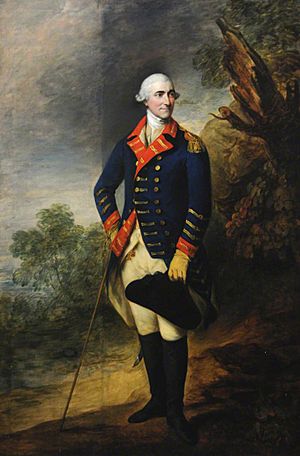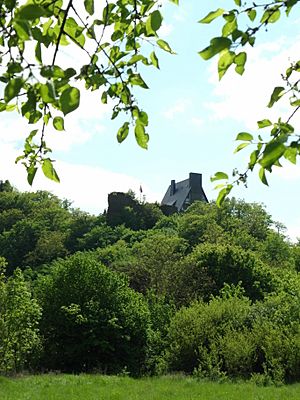Henry Seymour Conway facts for kids
Field Marshal Henry Seymour Conway (1721 – 9 July 1795) was an important British general and statesman. He was the brother of the 1st Marquess of Hertford and a cousin of Horace Walpole. Conway started his military career during the War of the Austrian Succession. He held many important government jobs, including Chief Secretary for Ireland and Secretary of State for the Northern Department. He eventually became the Commander-in-Chief of the Forces, which was a very high military position.
Contents
Growing Up and Education
Henry Seymour Conway was born in 1721. He was the second son of Francis Seymour-Conway, 1st Baron Conway. In 1732, he went to Eton College, a famous school. While there, he became very good friends with his cousin, Horace Walpole.
Early Military Career
Conway began his army career in 1737 as a lieutenant in the Molesworth's Regiment of Dragoons. He later joined the 1st Foot Guards. He was promoted to captain in 1741 and then to captain-lieutenant (like a lieutenant colonel) in 1742.
During the War of Austrian Succession, Conway served with important generals. He was at the Battle of Dettingen in 1743 and the Battle of Fontenoy in 1745. In 1746, he became a colonel of the 48th Foot. He fought in the Battle of Culloden later that year during the Jacobite Rebellion. In 1747, he fought at the Battle of Lauffeld. He was captured by the French but was released a few days later. In 1749, he moved to the 34th Foot and served in Menorca in 1751.
Starting in Politics
In 1741, Conway was elected to the Irish House of Commons for County Antrim. He was also elected to the British Parliament for Higham Ferrers. He was elected again for Penryn in 1747 and St Mawes in 1754. In 1755, he was promoted to major-general in the army.
In 1755, he became Chief Secretary for Ireland. This was a surprise appointment. He worked to solve political problems in Ireland and helped reach a compromise. In 1757, he became a Groom of the Bedchamber for King George II and later King George III.
Serving in the Seven Years' War
Conway was the second-in-command for the British military during the Raid on Rochefort in 1757. He wanted to attack Fort Fouras, but his team only agreed to a night attack, which failed. The mission did not achieve anything, and it hurt his reputation. King George II did not use Conway in campaigns for a while.
In 1761, Conway served in Germany under John Manners, Marquess of Granby. He commanded a group of soldiers at the Battle of Villinghausen in July 1761. He was also at the Battle of Wilhelmsthal in June 1762. The next month, he captured Waldeck Castle. After peace talks began, he helped British troops leave Europe and returned to England in 1763.
Later Political Career
Conway was re-elected to the House of Commons in 1761 for Thetford. In 1761, he also became a member of the Privy Council.
He joined Lord Rockingham's government in 1765 as Secretary of State for the Southern Department. He then moved to the Northern Department in 1766, serving until 1768. In these roles, Conway supported a fair approach to the American colonies. He was a main supporter of repealing the Stamp Act. He also disagreed with the tax policies of Charles Townshend.
Return to the Army and Retirement
After leaving his government roles in 1768, Conway returned to the military. He became a full general in 1772. He was also made Governor of Jersey in 1772. He continued to be an important voice in the House of Commons. He spoke out against Britain's efforts to stop the American Revolt.
In 1782, he was given a cabinet position and became Commander-in-Chief of the Forces. His political career ended in 1784 when he lost his seat in parliament. After that, he focused on his military duties. He retired completely in 1793. He was promoted to field marshal in 1793. Henry Seymour Conway passed away at his home, Park Place, on 9 July 1795.
Family Life
In 1747, Henry Seymour Conway married Caroline. She was the widow of Charles Bruce, 4th Earl of Elgin and 3rd Earl of Ailesbury. Caroline was the daughter of Lieutenant-General John Campbell. They had one daughter, Anne Seymour Damer, who became a sculptor.
See also
- Conway's Bridge at Park Place



